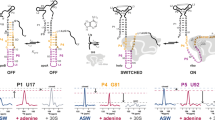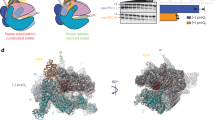Abstract
Proteins of the RsmA/CsrA family are global translational regulators in many bacterial species. We have determined the solution structure of a complex formed between the RsmE protein, a member of this family from Pseudomonas fluorescens, and a target RNA encompassing the ribosome-binding site of the hcnA gene. The RsmE homodimer with its two RNA-binding sites makes optimal contact with an 5′-A/UCANGGANGU/A-3′ sequence in the mRNA. When tightly gripped by RsmE, the ANGGAN core folds into a loop, favoring the formation of a 3-base-pair stem by flanking nucleotides. We validated these findings by in vivo and in vitro mutational analyses. The structure of the complex explains well how, by sequestering the Shine-Dalgarno sequence, the RsmA/CsrA proteins repress translation.
This is a preview of subscription content, access via your institution
Access options
Subscribe to this journal
Receive 12 print issues and online access
$189.00 per year
only $15.75 per issue
Buy this article
- Purchase on Springer Link
- Instant access to full article PDF
Prices may be subject to local taxes which are calculated during checkout




Similar content being viewed by others
References
Babitzke, P. & Romeo, T. CsrB sRNA family: sequestration of RNA binding regulatory proteins. Curr. Opin. Microbiol. 10, 156–163 (2007).
Haas, D. & Defago, G. Biological control of soil-borne pathogens by fluorescent pseudomonads. Nat. Rev. Microbiol. 3, 307–319 (2005).
Heeb, S. & Haas, D. Regulatory roles of the GacS/GacA two-component system in plant-associated and other gram-negative bacteria. Mol. Plant Microbe Interact. 14, 1351–1363 (2001).
Romeo, T. Global regulation by the small RNA-binding protein CsrA and the non-coding RNA molecule CsrB. Mol. Microbiol. 29, 1321–1330 (1998).
Valverde, C., Lindell, M., Wagner, E.G. & Haas, D. A repeated GGA motif is critical for the activity and stability of the riboregulator RsmY of Pseudomonas fluorescens. J. Biol. Chem. 279, 25066–25074 (2004).
Majdalani, N., Vanderpool, C.K. & Gottesman, S. Bacterial small RNA regulators. Crit. Rev. Biochem. Mol. Biol. 40, 93–113 (2005).
Winkler, W.C. & Breaker, R.R. Regulation of bacterial gene expression by riboswitches. Annu. Rev. Microbiol. 59, 487–517 (2005).
Winkler, W.C. Riboswitches and the role of noncoding RNAs in bacterial metabolic control. Curr. Opin. Chem. Biol. 9, 594–602 (2005).
Gutierrez, P. et al. Solution structure of the carbon storage regulator protein CsrA from Escherichia coli. J. Bacteriol. 187, 3496–3501 (2005).
Heeb, S. et al. Functional analysis of the post-transcriptional regulator RsmA reveals a novel RNA-binding site. J. Mol. Biol. 355, 1026–1036 (2006).
Rife, C. et al. Crystal structure of the global regulatory protein CsrA from Pseudomonas putida at 2.05 Å resolution reveals a new fold. Proteins 61, 449–453 (2005).
Mercante, J., Suzuki, K., Cheng, X., Babitzke, P. & Romeo, T. Comprehensive alanine-scanning mutagenesis of Escherichia coli CsrA defines two subdomains of critical functional importance. J. Biol. Chem. 281, 31832–31842 (2006).
Dubey, A.K., Baker, C.S., Romeo, T. & Babitzke, P. RNA sequence and secondary structure participate in high-affinity CsrA-RNA interaction. RNA 11, 1579–1587 (2005).
Blumer, C., Heeb, S., Pessi, G. & Haas, D. Global GacA-steered control of cyanide and exoprotease production in Pseudomonas fluorescens involves specific ribosome binding sites. Proc. Natl. Acad. Sci. USA 96, 14073–14078 (1999).
Heeb, S., Blumer, C. & Haas, D. Regulatory RNA as mediator in GacA/RsmA-dependent global control of exoproduct formation in Pseudomonas fluorescens CHA0. J. Bacteriol. 184, 1046–1056 (2002).
Kay, E., Dubuis, C. & Haas, D. Three small RNAs jointly ensure secondary metabolism and biocontrol in Pseudomonas fluorescens CHA0. Proc. Natl. Acad. Sci. USA 102, 17136–17141 (2005).
Reimmann, C., Valverde, C., Kay, E. & Haas, D. Posttranscriptional repression of GacS/GacA-controlled genes by the RNA-binding protein RsmE acting together with RsmA in the biocontrol strain Pseudomonas fluorescens CHA0. J. Bacteriol. 187, 276–285 (2005).
Valverde, C., Heeb, S., Keel, C. & Haas, D. RsmY, a small regulatory RNA, is required in concert with RsmZ for GacA-dependent expression of biocontrol traits in Pseudomonas fluorescens CHA0. Mol. Microbiol. 50, 1361–1379 (2003).
Wang, X. et al. CsrA post-transcriptionally represses pgaABCD, responsible for synthesis of a biofilm polysaccharide adhesin of Escherichia coli. Mol. Microbiol. 56, 1648–1663 (2005).
Liu, M.Y., Yang, H. & Romeo, T. The product of the pleiotropic Escherichia coli gene csrA modulates glycogen biosynthesis via effects on mRNA stability. J. Bacteriol. 177, 2663–2672 (1995).
Auweter, S.D., Oberstrass, F.C. & Allain, F.H. Sequence-specific binding of single-stranded RNA: is there a code for recognition? Nucleic Acids Res. 34, 4943–4959 (2006).
Shine, J. & Dalgarno, L. The 3′-terminal sequence of Escherichia coli 16S ribosomal RNA: complementarity to nonsense triplets and ribosome binding sites. Proc. Natl. Acad. Sci. USA 71, 1342–1346 (1974).
Ma, J., Campbell, A. & Karlin, S. Correlations between Shine-Dalgarno sequences and gene features such as predicted expression levels and operon structures. J. Bacteriol. 184, 5733–5745 (2002).
Yusupova, G.Z., Yusupov, M.M., Cate, J.H. & Noller, H.F. The path of messenger RNA through the ribosome. Cell 106, 233–241 (2001).
Jackson, D.W. et al. Biofilm formation and dispersal under the influence of the global regulator CsrA of Escherichia coli. J. Bacteriol. 184, 290–301 (2002).
Narberhaus, F., Waldminghaus, T. & Chowdhury, S. RNA thermometers. FEMS Microbiol. Rev. 30, 3–16 (2006).
Baker, C.S., Morozov, I., Suzuki, K., Romeo, T. & Babitzke, P. CsrA regulates glycogen biosynthesis by preventing translation of glgC in Escherichia coli. Mol. Microbiol. 44, 1599–1610 (2002).
Guntert, P., Mumenthaler, C. & Wuthrich, K. Torsion angle dynamics for NMR structure calculation with the new program DYANA. J. Mol. Biol. 273, 283–298 (1997).
Case, D.A. et al. AMBER Version 7 (University of California, San Francisco, 2002).
Cornell, W.D. et al. A 2nd generation force-field for the simulation of proteins, nucleic-acids, and organic-molecules. J. Am. Chem. Soc. 117, 5179–5197 (1995).
Bashford, D. & Case, D.A. Generalized born models of macromolecular solvation effects. Annu. Rev. Phys. Chem. 51, 129–152 (2000).
Miller, J.H. Experiments in Molecular Genetics (Cold Spring Harbor Laboratory Press, Cold Spring Harbor, New York, USA, 1972).
Acknowledgements
We thank C. Dominguez and R. Stefl for help with the structure calculation; K. Starke (Université de Lausanne) for supplying pME6624, pME6629 and pME6638; D. Witmer (ETH Zürich) for assistance in transcribing RNA and S. Auweter, C. Maris, M. Blatter, A. Clery, C. Reimmann and R. Glockshuber for helpful discussions. This investigation was supported by grants from the Swiss National Science Foundation to D.H. and F.H.-T.A., from the Structural Biology National Center of Competence in Research to F.H.-T.A. and I.J. and from the Roche Research Fund for Biology at the ETH Zurich to F.H.-T.A. F.H.-T.A. is a European Molecular Biology Organization Young Investigator.
Author information
Authors and Affiliations
Contributions
Protein and RNA samples for structural studies were prepared by M.S., O.D. and F.C.O. Functional experiments and cloning were carried out by K.L. and analyzed by K.L. and D.H. NMR data were analyzed by M.S., O.D. and F.H.-T.A. ITC measurements were performed by I.J. The structure calculation and refinement was carried out by M.S. The manuscript was written by M.S., D.H. and F.H.-T.A.
Corresponding authors
Ethics declarations
Competing interests
The authors declare no competing financial interests.
Supplementary information
Supplementary Text and Figures
Supplementary Figures 1–7, Supplementary Tables 1 and 2, Supplementary Methods (PDF 5757 kb)
Rights and permissions
About this article
Cite this article
Schubert, M., Lapouge, K., Duss, O. et al. Molecular basis of messenger RNA recognition by the specific bacterial repressing clamp RsmA/CsrA. Nat Struct Mol Biol 14, 807–813 (2007). https://doi.org/10.1038/nsmb1285
Received:
Accepted:
Published:
Issue Date:
DOI: https://doi.org/10.1038/nsmb1285
This article is cited by
-
RNA-binding proteins in bacteria
Nature Reviews Microbiology (2018)
-
A Canonical Biophysical Model of the CsrA Global Regulator Suggests Flexible Regulator-Target Interactions
Scientific Reports (2018)
-
Molecular basis of binding between the global post-transcriptional regulator CsrA and the T3SS chaperone CesT
Nature Communications (2018)
-
Prediction of bacterial small RNAs in the RsmA (CsrA) and ToxT pathways: a machine learning approach
BMC Genomics (2017)
-
Structural Insight into Inhibition of CsrA-RNA Interaction Revealed by Docking, Molecular Dynamics and Free Energy Calculations
Scientific Reports (2017)



